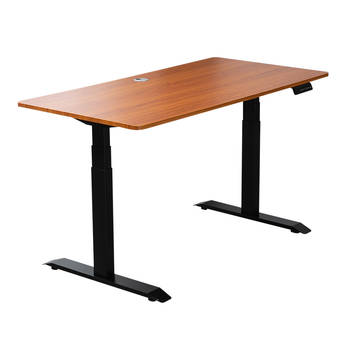Content
- 1 How does the electric standing desk address overseas office health pain points?
- 2 What functional innovations make electric standing desks competitive in cross-border markets?
- 3 How do electric standing desks adapt to diverse overseas living and working scenarios?
- 4 How do electric standing desks meet overseas safety and quality certification standards?
- 5 How does the user-centric design enhance the cross-border appeal of electric standing desks?
In recent years, the global emphasis on office health has intensified—with remote work and prolonged sitting becoming normalized, consumers are increasingly seeking solutions to alleviate work-related health issues. Against this backdrop, the electric standing desk has emerged as a cross-border best-seller, captivating markets across continents. But what exactly drives its soaring popularity overseas? From health value to functional innovation, and from market adaptation to user experience, we explore the core questions behind its success.
How does the electric standing desk address overseas office health pain points?
The fundamental reason for the electric standing desk’s cross-border success lies in its precise targeting of universal office health needs. Overseas consumers, especially in regions like North America, Europe, and Southeast Asia, are deeply concerned about the health risks of prolonged sitting—such as back pain, neck strain, and metabolic issues, which have been widely highlighted by medical research and media reports. How does this product solve these pain points? Unlike traditional fixed desks, electric standing desks allow users to switch between sitting and standing positions with a simple button press, promoting blood circulation, reducing spinal pressure, and relieving muscle fatigue. Additionally, many products offer height memory functions, enabling users to store personalized sitting and standing heights, catering to different body types and usage habits. This focus on practical health benefits resonates with overseas consumers’ growing willingness to invest in "preventive health products," making the electric standing desk more than just office furniture but a necessary health tool.
What functional innovations make electric standing desks competitive in cross-border markets?
Beyond basic height adjustment, functional innovations have significantly enhanced the competitiveness of electric standing desks in overseas markets. What key features meet the diverse needs of international users? First, quiet motor technology is a crucial selling point—overseas consumers value a peaceful work environment, so desks with low-noise motors (usually below 50 decibels) are highly sought after, whether for home offices or shared workspaces. Second, stability and load-bearing capacity are non-negotiable: overseas users often place multiple devices (laptops, monitors, printers) on their desks, so products with sturdy frames and high load-bearing limits (typically 80-120kg) gain trust. Third, smart integration caters to tech-savvy markets—some desks support Bluetooth or app connectivity, allowing users to track standing time, set height reminders, or sync with health apps, aligning with the global smart home trend. Additionally, anti-collision sensors, which automatically stop the desk from moving when encountering obstacles, address safety concerns, a key factor for families with children or pets in overseas households.
How do electric standing desks adapt to diverse overseas living and working scenarios?
Cross-border success requires adapting to varying living and working environments across markets—how does the electric standing desk achieve this versatility? For small living spaces, which are common in European cities and Japanese urban areas, compact and foldable designs are popular: these desks save space when not in use, fitting seamlessly into studio apartments or multi-functional rooms. In contrast, North American consumers, who often have larger home offices, prefer extra-wide desktop models that can accommodate dual monitors and work accessories. Moreover, the product’s compatibility with different power standards is critical—adapting to 110V (US, Canada) and 220V (EU, Asia) power grids, along with universal plug adapters, eliminates cross-border usage barriers. For remote workers and digital nomads, lightweight and easy-to-assemble designs are essential, as they facilitate frequent moves or international relocations. This ability to cater to diverse spatial and usage needs allows the electric standing desk to penetrate multiple overseas market segments.
How do electric standing desks meet overseas safety and quality certification standards?
Overseas markets have strict regulations on office furniture, especially for electrical products—and compliance is a prerequisite for becoming a best-seller. How do electric standing desks meet these rigorous standards? First, electrical safety certifications are mandatory: products sold in the EU must comply with CE certification, while those entering the US need FCC and UL certifications, ensuring that motors and electrical components meet fire and electric shock prevention standards. Second, material safety is paramount—desktops made of formaldehyde-free, eco-friendly materials (such as FSC-certified wood or low-VOC particleboard) align with overseas environmental and health requirements, especially in markets like Germany and Scandinavia where eco-consciousness is high. Third, structural safety testing, including stability tests, height adjustment cycle tests, and load-bearing durability tests, ensures that products can withstand long-term use, reducing after-sales risks. Compliance with these standards not only allows the desks to enter overseas markets legally but also builds consumer trust, a key driver of repeat purchases and word-of-mouth promotion.
How does the user-centric design enhance the cross-border appeal of electric standing desks?
In addition to health and functionality, user-centric design details have played a pivotal role in the electric standing desk’s cross-border success. What design elements resonate with overseas consumers? Ergonomic considerations are central: desktops with rounded edges prevent accidental scratches, while adjustable feet compensate for uneven floors, ensuring stability on various surfaces. Cable management systems—such as built-in cable holes or under-desk cable trays—address the clutter of electronic devices, a common annoyance for overseas users who value organized workspaces. Furthermore, inclusive design caters to a wide range of users: desks with a broad height adjustment range (typically 70-120cm) accommodate children, adults, and even tall users, making them suitable for family use or shared workspaces. Color options also align with global aesthetic trends—neutral tones like white, gray, and black blend with various interior styles, from minimalist Scandinavian homes to industrial-style offices. These thoughtful details enhance the overall user experience, differentiating electric standing desks from traditional office furniture and boosting their cross-border appeal.

 English
English 中文简体
中文简体 日本語
日本語 한국어
한국어 Español
Español
 Language
Language












